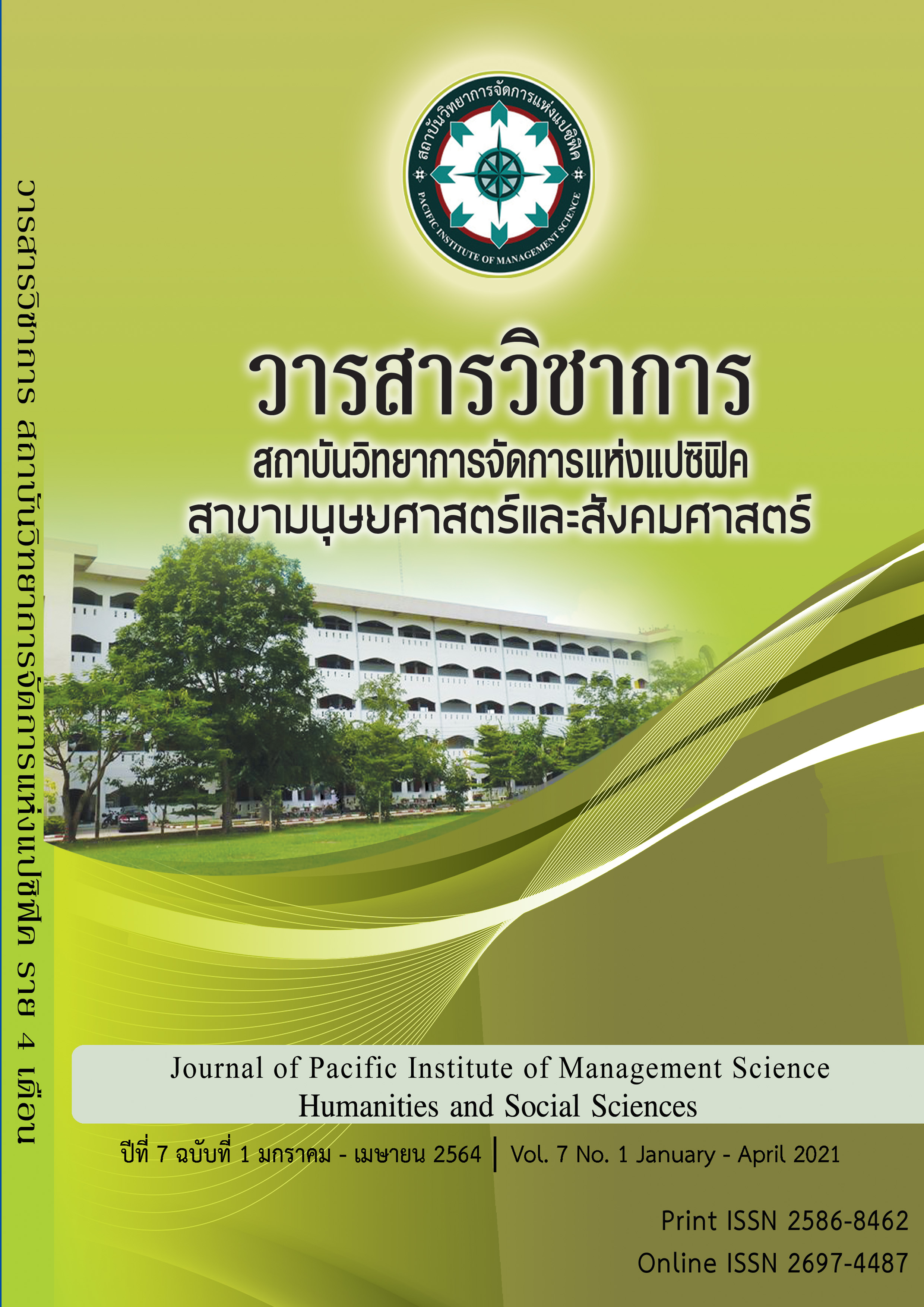การพัฒนาชุดกิจกรรมละครสร้างสรรค์เพื่อส่งเสริมทักษะการคิดที่มีอิทธิพลต่อพฤติกรรมการยับยั้งชั่งใจในเด็กปฐมวัย
คำสำคัญ:
กิจกรรมละครสร้างสรรค์, ทักษะการคิด, พฤติกรรมการยับยั้งชั่งใจบทคัดย่อ
การวิจัยการพัฒนาชุดกิจกรรมละครสร้างสรรค์เพื่อส่งเสริมทักษะการคิดที่มีอิทธิพลต่อพฤติกรรมการยับยั้งชั่งใจในเด็กปฐมวัยมีวัตถุประสงค์เพื่อสร้างชุดกิจกรรมละครสร้างสรรค์เพื่อส่งเสริมทักษะการคิดที่มีอิทธิพลต่อพฤติกรรมการยับยั้งชั่งใจในเด็กปฐมวัย และเพื่อเปรียบเทียบทักษะการคิดที่มีอิทธิพลต่อพฤติกรรมการยับยั้งชั่งใจ โดยศึกษากับนักเรียนก่อนวัยเรียนเพศชายและหญิงในระดับอายุ 4 – 6 ปี ของโรงเรียนอนุบาลอุทิศศึกษา ที่มีปัญหาการคิดส่งผลต่อพฤติกรรมการยับยั้งชั่งใจ 3 ด้านคือ การหยุดการยับยั้งพฤติกรรม, การควบคุมอารมณ์ และการวางแผนจัดการ จำนวน 19 คน ผลวิจัยพบว่า 1.) ได้ชุดกิจกรรมละครสร้างสรรค์ในการพัฒนาทักษะการคิดที่มีอิทธิพลต่อพฤติกรรมการยับยั้งชั่งใจ จำนวน 12 แผนกิจกรรม ประกอบไปด้วยแผนกิจกรรมที่ 1 – 4 พัฒนาด้านการหยุดการยับยั้งพฤติกรรม, แผนกิจกรรมที่ 5 – 8 พัฒนาด้านการควบคุมอารมณ์ และแผนกิจกรรมที่ 9 – 12 พัฒนาด้านการวางแผนจัดการ โดยรูปแบบกิจกรรมละครสร้างสรรค์ได้ผ่านการพิจารณาจากผู้ทรงคุณวุฒิมีความเหมาะสม และค่าความสอดคล้อง (IOC) ของกิจกรรมอยู่ในระดับมากที่สุด 2.) ผลการทดลองเพื่อเปรียบเทียบตัวบ่งชี้ทักษะการคิดที่มีอิทธิพลต่อพฤติกรรมการยับยั้งชั่งใจ ก่อนและหลังการจัดกิจกรรมละครสร้างสรรค์ทั้ง 3 ด้าน มีระดับคะแนนเฉลี่ยก่อนจัดกิจกรรมจะต่ำกว่าหลังจัดกิจกรรม โดยจากการใช้แบบประเมินตัวบ่งชี้พัฒนาการด้านการควบคุมอารมณ์ ผลประเมินอยู่ในระดับสูงสุด รองลงมา ตัวบ่งชี้พัฒนาการด้านการวางแผนจัดการ และตัวบ่งชี้พัฒนาการด้านการหยุดการยับยั้งพฤติกรรม ตามลำดับ
เอกสารอ้างอิง
ดุษฎี อุปการ, และ อรปรียา ญาณะชัย. (2561). การเสริมสร้างพัฒนาการการเรียนรู้ของเด็กปฐมวัยควรเลือกใช้หลักการใด: “การเรียนรู้โดยใช้สมองเป็นฐาน” หรือ “การคิดเชิงบริหาร”. วารสารวิชาการ Veridian E-Journal สาขามนุษยศาสตร์ สังคมศาสตร์ และศิลปะ, 11(1): 209-215.
ปราณี เมืองน้อย, พัฏ โรจน์มหามงคล, อิสราภา ชื่นสุวรรณ, สุธาทิพย์ เอมเปรมศิลป์, และ วินัดดา ปิยะ. (2560). คู่มือสำหรับพ่อแม่เพื่อเผยแพร่ความรู้ด้านการดูแลและพัฒนาเด็ก ตอนวัยอนุบาล 3-6 ปี. กรุงเทพฯ: ราชวิทยาลัยกุมารแพทย์แห่งประเทศไทย สมาคมกุมารแพทย์แห่งประเทศไทย.
พนมาน เทียนมนัส. (2539). ความเชื่อมั่นในตนเองของเด็กปฐมวัยที่ได้รับการจัดประสบการณ์การเล่านิทานประกอบการแสดงละครสร้างสรรค์และประกอบการวาดภาพ. ปริญญานิพนธ์การศึกษามหาบัณฑิต มหาวิทยาลัยศรีนครินทรวิโรฒ.
สุภาภรณ์ บัณฑิตย์. (2556). เอกสารชุดวิชา ECED211: จิตวิทยาพัฒนาการสำหรับเด็กปฐมวัย. พิษณุโลก: สาขาวิชาการศึกษาปฐมวัย คณะครุศาสตร์ มหาวิทยาลัยราชภัฏพิบูลสงคราม.
สุภาวดี หาญเมธี. (2558). EF ภูมิคุ้มกันชีวิตและป้องกันยาเสพติดคู่มือสำหรับครูอนุบาล. กรุงเทพฯ: มติชน.
Gmitrova, V., & Juraj, G. (2003). The Impact of Teacher-Directed and Child-Directed Pretend Play on Cognitive Competence in Kindergarten Children. Early Childhood Education Journal, 30(4): 241-246.
Kohls, G., Peltzer, J., Herpertz-Dahlmann, B., & Konrad, K. (2009). Differential effects of social and non-social reward on response inhibition in children and adolescents. Dev Sci, 12(4): 614-625.
ดาวน์โหลด
เผยแพร่แล้ว
ฉบับ
ประเภทบทความ
สัญญาอนุญาต
บทความที่ได้รับการตีพิมพ์เป็นลิขสิทธิ์ของ สถาบันวิทยาการจัดการแห่งแปซิฟิค
ข้อความที่ปรากฏในบทความแต่ละเรื่องในวารสารวิชาการเล่มนี้เป็นความคิดเห็นส่วนตัวของผู้เขียนแต่ละท่านไม่เกี่ยวข้องกับสถาบันวิทยาการจัดการแห่งแปซิฟิค และคณาจารย์ท่านอื่นๆในสถาบันฯ แต่อย่างใด ความรับผิดชอบองค์ประกอบทั้งหมดของบทความแต่ละเรื่องเป็นของผู้เขียนแต่ละท่าน หากมีความผิดพลาดใดๆ ผู้เขียนแต่ละท่านจะรับผิดชอบบทความของตนเองแต่ผู้เดียว







